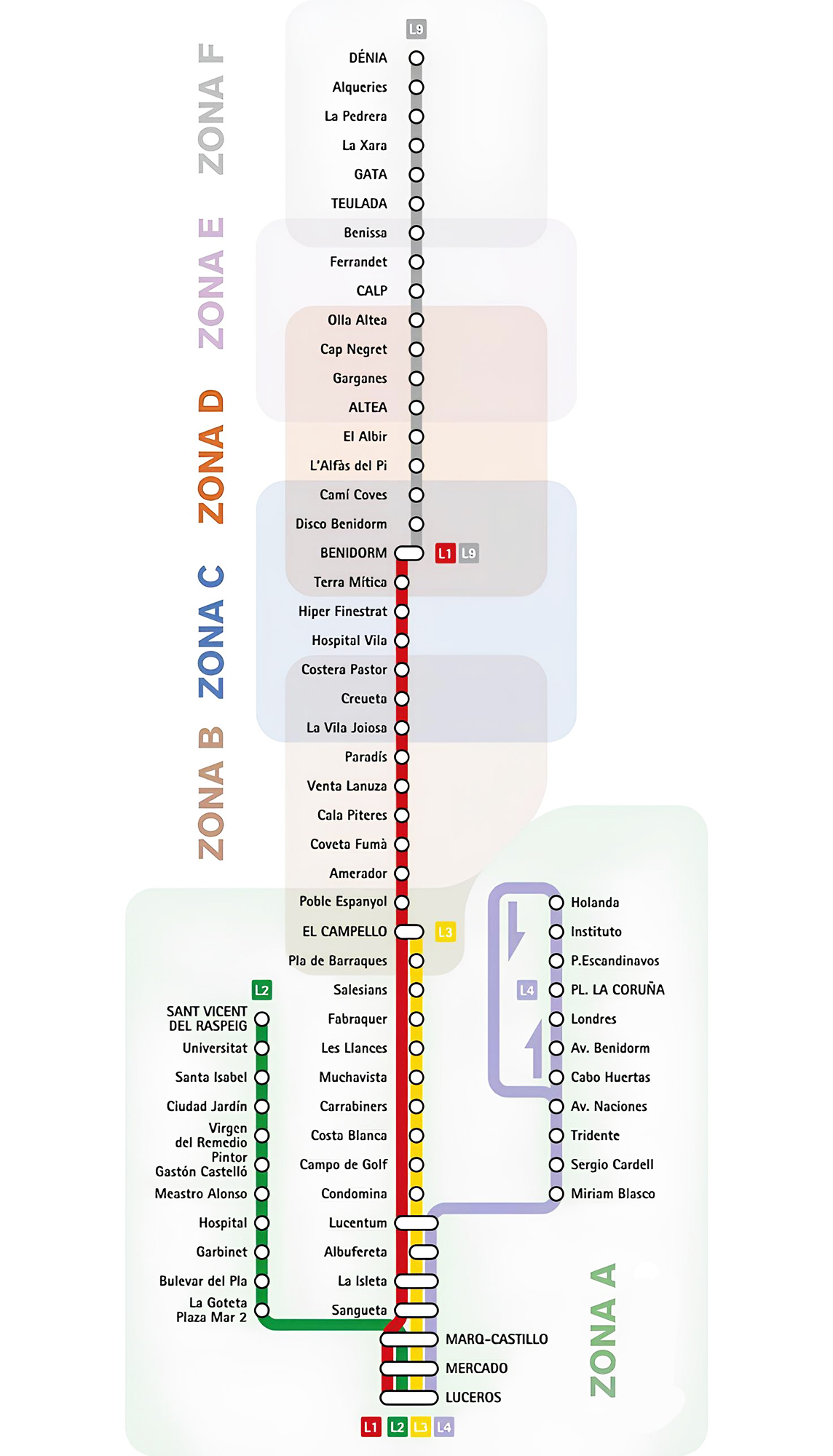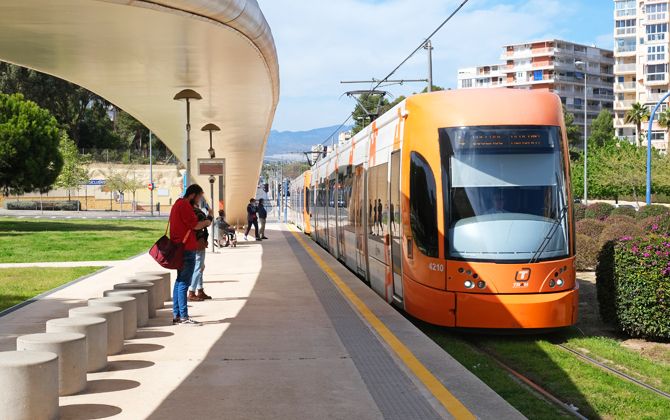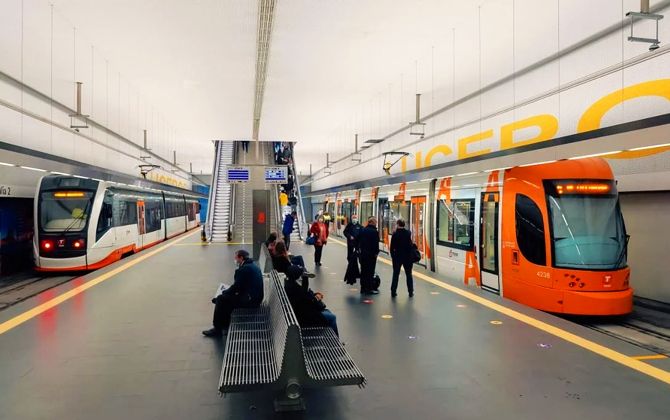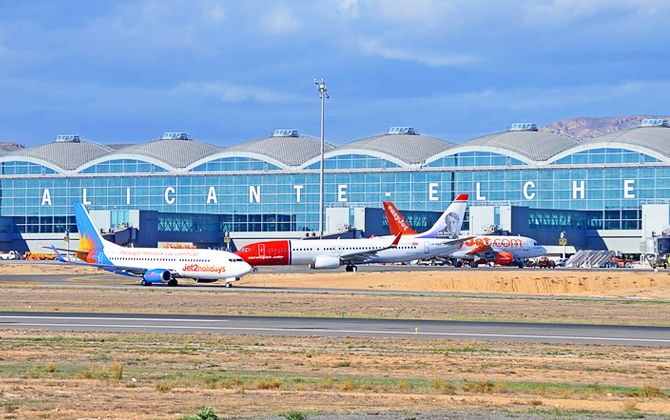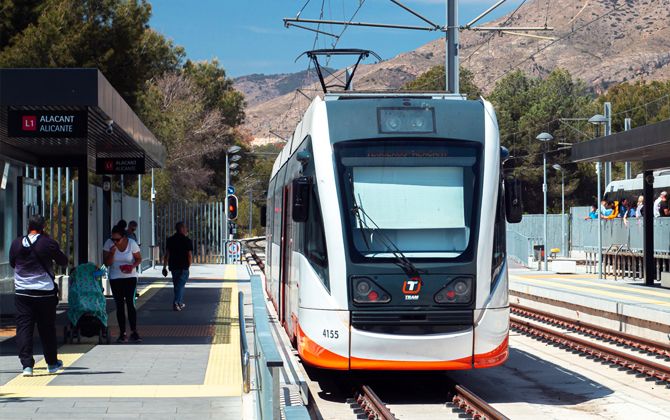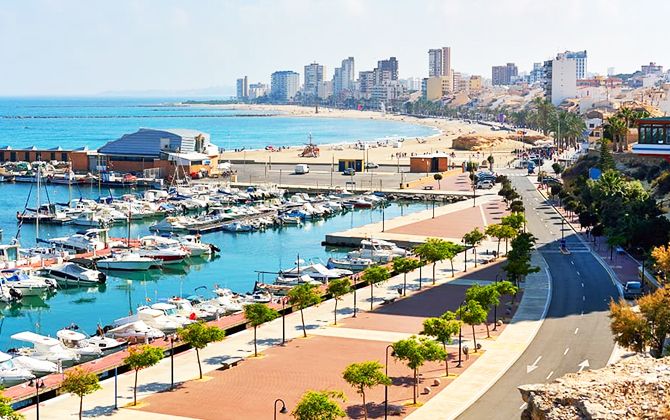The Alicante TRAM is a modern light-rail network that serves the city and its metropolitan area. It has six lines and about 70 stations, covering 112 km (69.7 mi) of track. The system combines underground tram lines in the city center with overground tram-train routes to coastal towns (lines 1–4, 5). Line 9 uses diesel trains to connect northern destinations. As of 2024, the TRAM carries around 55,500 passengers per day, or about 20.3 million per year. The network links central Alicante (Luceros–MARQ tunnel) with beaches and towns across the province, making it the backbone of local public transport.
Metropolitano Map of Alicante
The 2026 TRAM map shows all lines and fare zones. Six lines radiate from the city: five (L1–L5) serve Alicante and nearby towns, while line L9 runs along the coast to Dénia. Lines 1–4 (Luceros–Benidorm/El Campello/La Coruña) share the central underground tunnel between Luceros and MARQ. Line 5 runs in a loop from Porta del Mar to Plaza La Coruña (San Juan Beach). Each line is color-coded on the map, with fare zones clearly marked. Zone A covers central Alicante (all of L2–L5 and the Luceros–Poble Espanyol section of L1), while outer zones apply to coastal stretches. Major transfer points include Luceros, Mercado, and MARQ-Castillo.
Map of Alicante Tram showing different lines. Click on the map to enlarge it or download the TRAM Metropolitano de Alicante map in PDF format.
Lines and Stations of Alicante’s Tram
The TRAM network has six active lines. Below are the terminals, distances, and station counts for each line.
Line 1 (Luceros–Benidorm)
Length: 44.6 km (27.7 mi), 20 stations. Main stops: Luceros and Mercado in central Alicante, Alicante General Hospital, El Campello (old town), La Vila Joiosa (Villajoyosa), and Benidorm Intermodal. The line links downtown with northern resorts and coastal towns.
Line 2 (Luceros–San Vicente del Raspeig)
Length: 7.2 km (4.5 mi), 14 stations. Main stops: Luceros, Plaza Mar 2 shopping center, Hospital de Sant Joan de Déu, University (Universitat), and Sant Vicent del Raspeig. Travel time is about 28 minutes.
Line 3 (Luceros–El Campello)
Length: 14.4 km (8.9 mi), 17 stations. It shares the central tunnel (Luceros, Mercado, MARQ-Castillo) with L1–L4 before heading northeast to El Campello. Key stops include Luceros (city center) and Fabraquer.
Line 4 (Luceros–Plaza La Coruña)
Length: 14.6 km (9.1 mi), 18 stations. From Luceros, it runs underground through MARQ-Castillo and Mercado, then east to San Juan Beach. Important stops: La Condomina (shopping mall), Santa Faz (monastery area), and Estación de RENFE. It terminates at Plaza La Coruña.
Line 5 (Porta del Mar–Plaza La Coruña)
Length: 13.3 km (8.3 mi), 17 stations. Starts at Porta del Mar (Playa del Postiguet), follows the same loop as L4 via La Condomina and Santa Faz, and ends at Plaza La Coruña (San Juan Beach). This route continues the old “4L” service (1999–2013).
Line 9 (Benidorm–Dénia)
Length: 50.9 km (31.6 mi), 18 stations. This former ADIF regional railway (meter gauge) is now part of the TRAM. It runs north from Benidorm along the coast through Calp (Calpe) and Altea to Dénia. Key stops: Benidorm Intermodal (with connection to L1), Calp, Altea, and L’Alfàs del Pi. The service is diesel-powered and recently modernized.
Line 1 connects central Alicante with El Campello and Villajoyosa, while Line 9 serves tourist towns like Calpe, Altea, and Dénia. Downtown stations (Luceros, Mercado, MARQ-Castillo) serve the old town and museum district. Porta del Mar and Plaza La Coruña provide easy access to Postiguet and San Juan beaches. All stations are clearly marked and follow FGV branding.
Fares and Tickets
Fares are zone-based. Zone A covers central Alicante and has a flat rate. Extra zones apply for longer trips. Tickets are available in paper form or on the Tarjeta Móbilis card. A 10-trip “Bonotravels” pass offers savings for frequent riders. Below are standard adult fares:
| Ticket type | Price (EUR) | Price (USD) |
|---|---|---|
| Single (1 zone) | €1.45 | ~$1.60 |
| Single (all zones / 3 zones) | €3.90 | ~$4.30 |
| Return (1 zone) | €2.50 | ~$2.75 |
| Return (all zones) | €6.65 | ~$7.30 |
| 10-ride pass (1 zone) | €8.00 | ~$8.80 |
| 10-ride pass (all zones) | €20.00 | ~$22.00 |
| Day ticket (24h, all zones) | €8.00 | ~$8.80 |
Tickets must be validated at station entry or when boarding. Children under 10 travel free with a paying adult. Reduced fares are available for youth, students, and other groups with personalized cards.
Note: Single tickets do not allow transfers. Bonotravels and Móbilis cards permit transfers within 60 minutes on the TAM integrated system.
Schedule of Alicante’s Tram
The TRAM runs daily from early morning to late evening. First trains leave around 5–6 AM, and last services finish about 10–10:30 PM, depending on the line.
Frequency varies by section and time of day. In central Alicante (Luceros–MARQ), Lines 1–4 together provide a train every 7–15 minutes during peak hours. On outer sections, each line runs every 15–30 minutes during the day.
Line 9 (Benidorm–Dénia) runs about once per hour from 05:50 to 20:50. The last train from Dénia that connects to Alicante leaves around 19:50.
Travel times:
- Line 2 (Luceros–Sant Vicent): ~28 minutes
- Line 1 (Luceros–Benidorm): ~70 minutes
- Full trip Dénia–Alicante (via Line 9 and transfer at Benidorm): ~3 hours
Off-peak frequencies are lower, especially midday and weekends. Timetables are posted at stations.
Connections
The Alicante TRAM integrates with other public transport. The TAM bus network (municipal and interurban buses) connects to many TRAM stops. Plaza Luceros, the main tram hub, is served by TAM lines 02, 09, 21, 23, 24, and 27. In 2023, TAM Line 06 was added to link the Alicante Bus Station, Renfe AVE station, and Luceros tram stop. Other lines, such as 21 and 38, stop near Av. Benidorm (Tram) station. Buses run frequently, making transfers convenient. Long-distance buses arrive at Alicante Bus Station in the city center, a short walk from Luceros (lines L1–L4).
Access to the Airport
Alicante–Elche Airport (ALC) is 12 km (7.5 mi) south of the city. It is served by the C6 Aeropuerto bus, which stops at Plaza de Luceros (next to Luceros tram station, L1–L4) and Plaza Puerta del Mar (near Porta del Mar stop, L5). The C6 runs every 20 minutes daily, with a journey time of 25–30 minutes.
Travelers can also take a taxi or rideshare to the city center in 15–20 minutes. The fare is about €25–30 (~$27–32).
Tips and Rules
Validate your fare: Always validate tickets or scan your card when boarding. Single tickets do not allow transfers, so choose carefully. For multiple rides, use a 10-journey Bonotravels (Tarjeta Móbilis) or a season pass to save money.
Travel card: The rechargeable TAM Móbilis card allows transfers within 60 minutes on buses and trams (not valid with single tickets). Cards can be purchased and recharged at station machines.
Carry small change: Ticket machines and buses may not give change. Keep coins ready, especially for the airport bus.
Peak season: In summer, coastal and beach lines (e.g., to Benidorm or Altea) are very busy. Board early or use end-of-line stations to secure a seat.
Off-peak travel: Midday and late evening trams are less crowded, but service is less frequent. Check schedules in advance.
Behavior: Give priority seats to elderly and disabled passengers, keep noise low, and fold or remove bicycles unless using designated areas. Smoking and alcohol are prohibited.
Children: Up to two children under 10 travel free with a paying adult. ID may be required for discounted fares.
Safety: The tram is safe, but keep an eye on belongings in crowded stations such as Luceros.
History
Alicante’s tram history dates back to the early 20th century. The original narrow-gauge railway to Dénia opened in stages: Alicante–Altea in 1914 and to Dénia in 1915. It carried both freight and passengers. Streetcar service in the city ended in 1969, when tram operations ceased.
In 1987 the Generalitat (FGV) took over regional lines. The modern TRAM began later: on 13 March 1999, a trial section opened between Puerta del Mar and Albufereta. The first full tram-train service launched on 15 August 2003 from Puerta del Mar to El Campello, making Alicante the fifth Spanish city with a metro-style tram after Madrid, Barcelona, Bilbao, and Valencia.
From 2007 to 2010 the network expanded quickly. An underground tunnel linked central stops Mercado and Luceros. On 15 June 2007, Line 4 opened to Playa de San Juan. On 2 June 2008, Line 1 extended north to Benidorm. On 18 June 2010, Luceros station opened as the new hub. Line 2 (Luceros–San Vicente del Raspeig/University) began service on 4 September 2013.
On 10 June 2019, Line 5 (Porta del Mar–Plaza La Coruña) opened, replacing the short-lived Line 4L shuttle (1999–2013). In January 2023, modernization of Line 9 (Benidorm–Dénia) was completed. The Gata de Gorgos–Dénia section reopened on 16 January 2023. New Stadler “Dual” diesel-electric trains now serve L9.
Over time, the Alicante TRAM has expanded its reach, replacing older railways with frequent light rail. Today, six lines (1, 2, 3, 4, 5, and 9) are active. The only retired service is the temporary “4L” shuttle.
Fun Facts
- Network size: 70 stations and 111.7 km (69.4 mi) of track. Gauge: 1,000 mm (metre gauge).
- Ridership: About 55,500 daily riders; record 20.3 million passengers in 2024.
- Longest & shortest lines: L9 (Benidorm–Dénia) is the longest at 50.9 km (31.6 mi). L5 (Porta del Mar–La Coruña) is the shortest at 13.3 km (8.3 mi).
- Historic first: When L1 to Benidorm opened in 2008, Alicante became the first Spanish city to combine an underground tram with train-tram tracks. It was the fifth city in Spain with a modern high-capacity tram system (after Madrid, Barcelona, Bilbao, and Valencia).
- Tunnel core: The Luceros–MARQ tunnel (opened 2007–2010) is 2.2 km (1.4 mi) long. Luceros station, 2,200 m² in size, opened in 2010 and handles ~8 trains/hour at peak.
- Name: Locals call it “El Tram” (Valencian) or “El Tran” (Spanish).
- Rolling stock: Low-floor Alstom/FCC trams operate in the city, while new dual-mode Stadler FLIRT train-trams run on L9.
- Record: In 2022, the TRAM carried over 13 million passengers. Luceros was the busiest station with 2.11 million riders.
Nearby Attractions
The TRAM gives easy access to many sights in Alicante and nearby towns:
Alicante City Center: Luceros and Mercado stations serve downtown. From Luceros, you can walk to the Explanada de España promenade, the Old Town (Casco Antiguo), Santa Bárbara Castle (via short walk or bus), and the port. Mercado Central and the MARQ Archaeological Museum are near Mercado-Castillo station.
Beaches: Porta del Mar station is next to Postiguet Beach in central Alicante. San Juan Beach is served by Lines 4 and 5 at Santa Faz and Plaza La Coruña. Albufereta Beach is near Albufereta stop (L1).
University / Hospital: Line 2 connects to the University of Alicante (Universitat stop) and Sant Joan Hospital (Hospital General stop).
El Campello: A coastal town with beaches and a harbor, accessible via L3 (El Campello terminus).
Villajoyosa (La Vila Joiosa): Known for its colorful houses and seaside promenade. Reachable by L1 at Villajoyosa station.
Benidorm: A major resort city with high-rise beaches, nightlife, and the Terra Mítica theme park. Benidorm TRAM station (L1 terminus) connects to the Intermodal hub. Terra Mítica is near the L1 Terra Mítica stop.
Costa Blanca towns: Line 9 serves Calp (Calpe), Altea, and Dénia. Calp and Altea have popular beaches and old towns. Dénia offers a castle and a ferry port. These towns are reachable via L9 with a transfer at Benidorm.
Other: Santa Faz monastery is near Santa Faz stop (L4). La Cañada stop (L4) is close to the Villafranqueza shopping area. Many coastal paths and parks are also within walking distance of tram stations.
All attractions can be reached affordably by combining the TRAM with short walks or local buses.
Future Extensions
Plans for further expansion are in progress. The most advanced project is extending the underground tunnel from Luceros to the new Intermodal station, Alicante’s main RENFE/AVE rail hub. This will allow direct transfers between tram and high-speed trains and could also connect to the relocated bus station. In April 2022, the Valencian government approved funding to move the Luceros–RENFE tram link forward.
Other proposals are still at the planning stage. These include:
- A new Line 6 from the Intermodal (RENFE) station to the Hospital de Sant Vicent del Raspeig.
- Extensions south to La Florida and San Gabriel neighborhoods.
- A tram link to Alicante–Sant Joan Hospital and further north to San Juan.
- A coastal tram between Orihuela and Torrevieja.
- A direct line from Elche to Alicante Airport.
No firm dates exist for these projects, but studies and funding talks continue. The TRAM is expected to remain the backbone of public transport in the province, with gradual growth improving regional connections.
